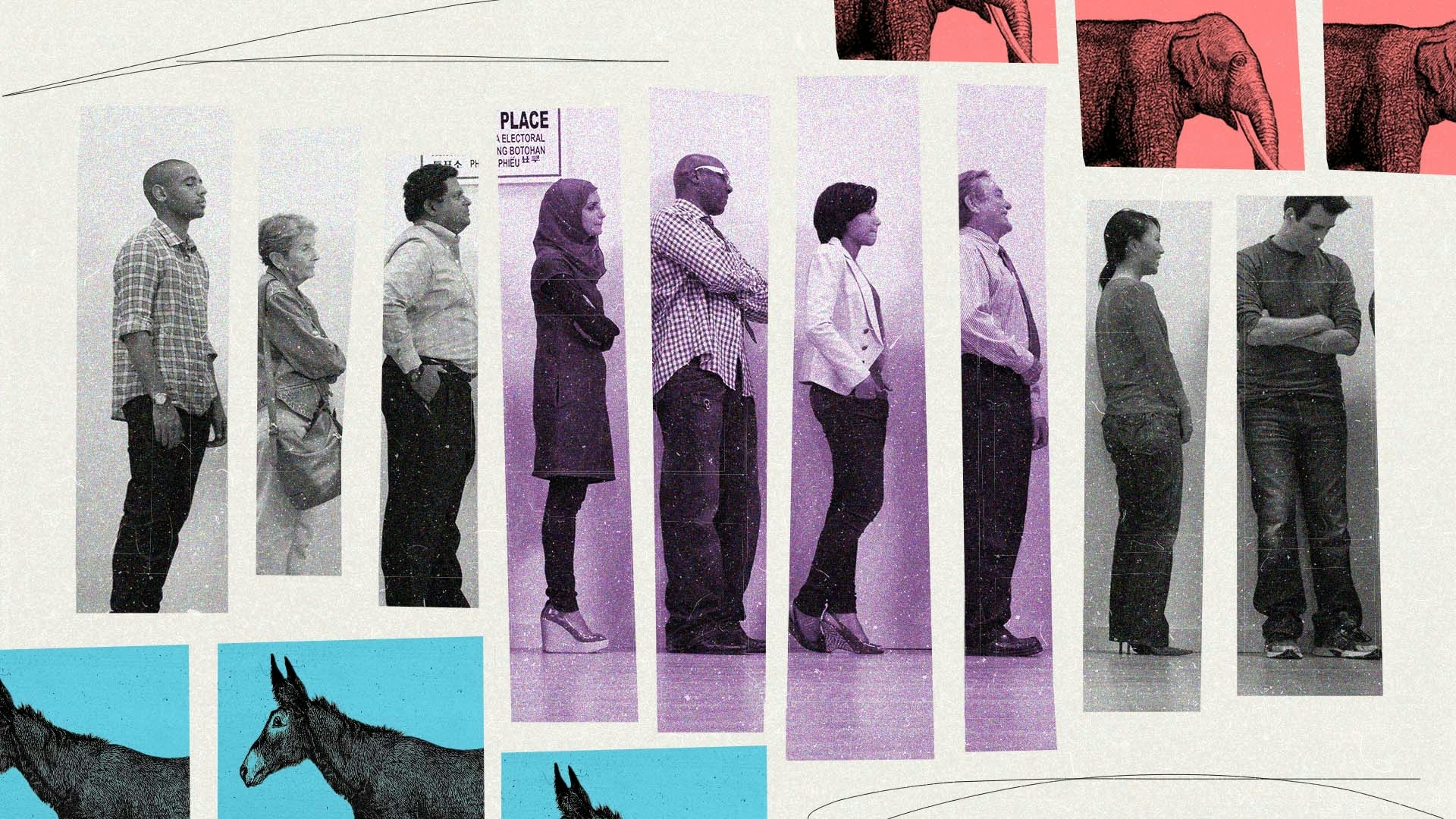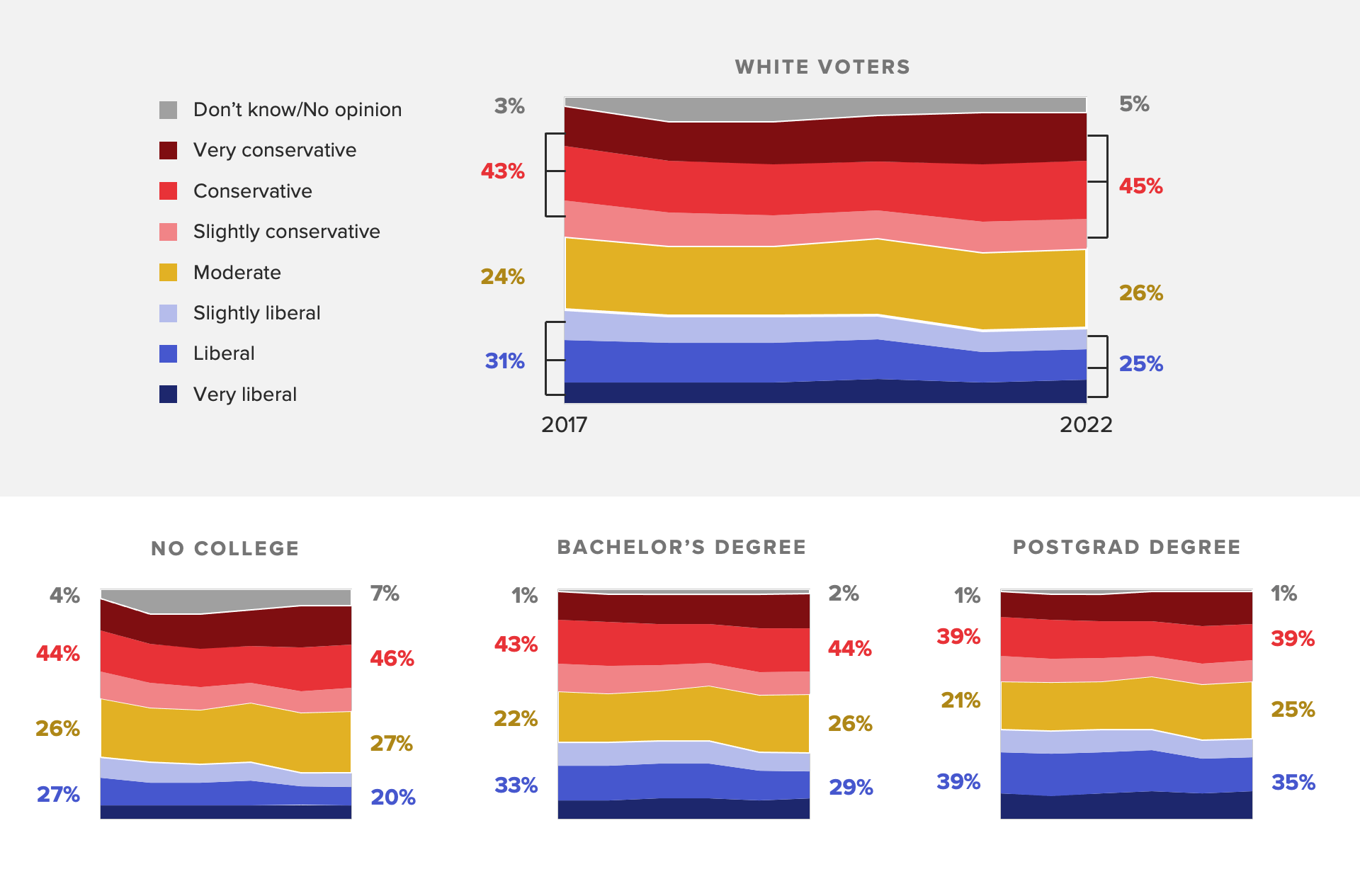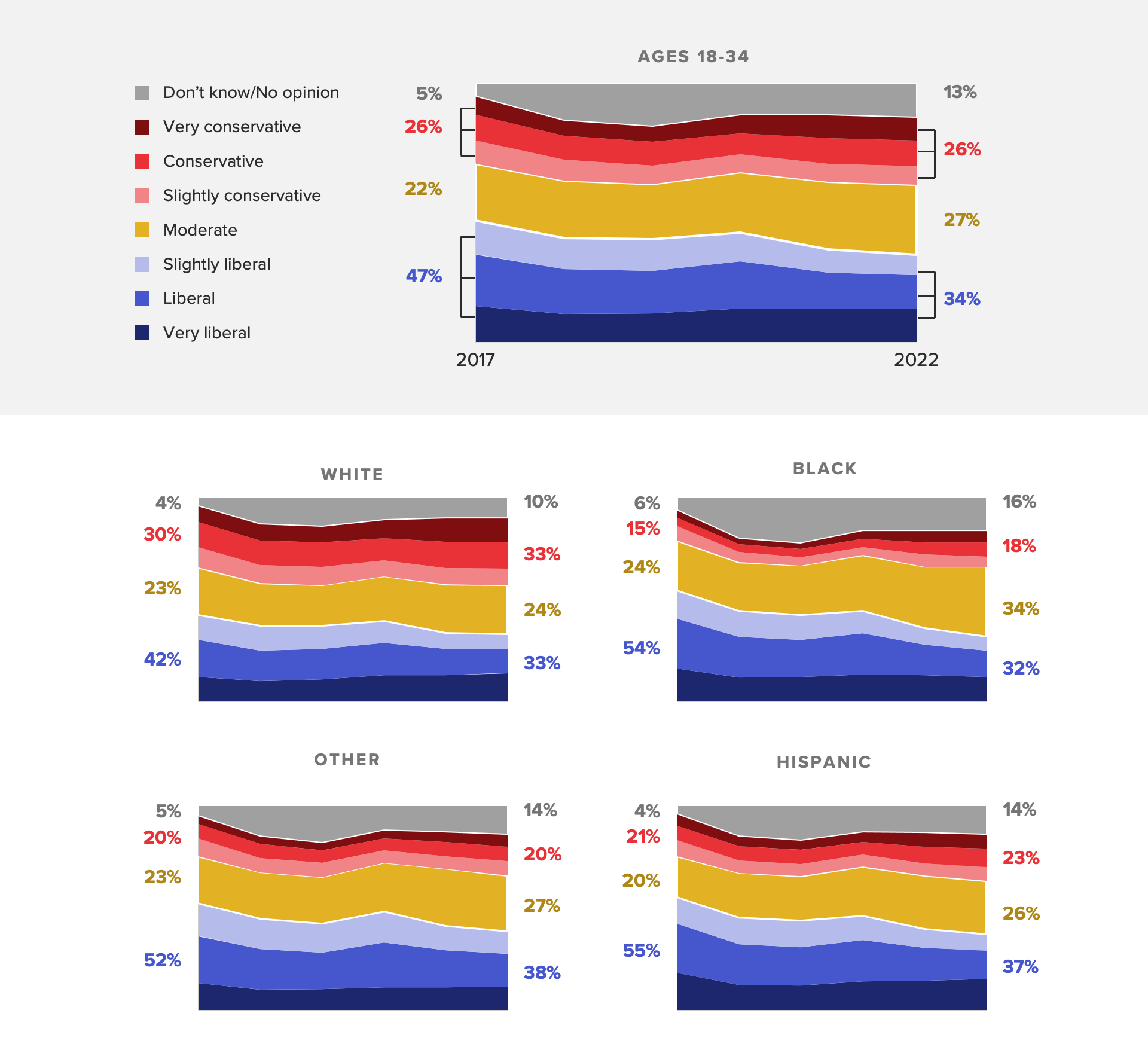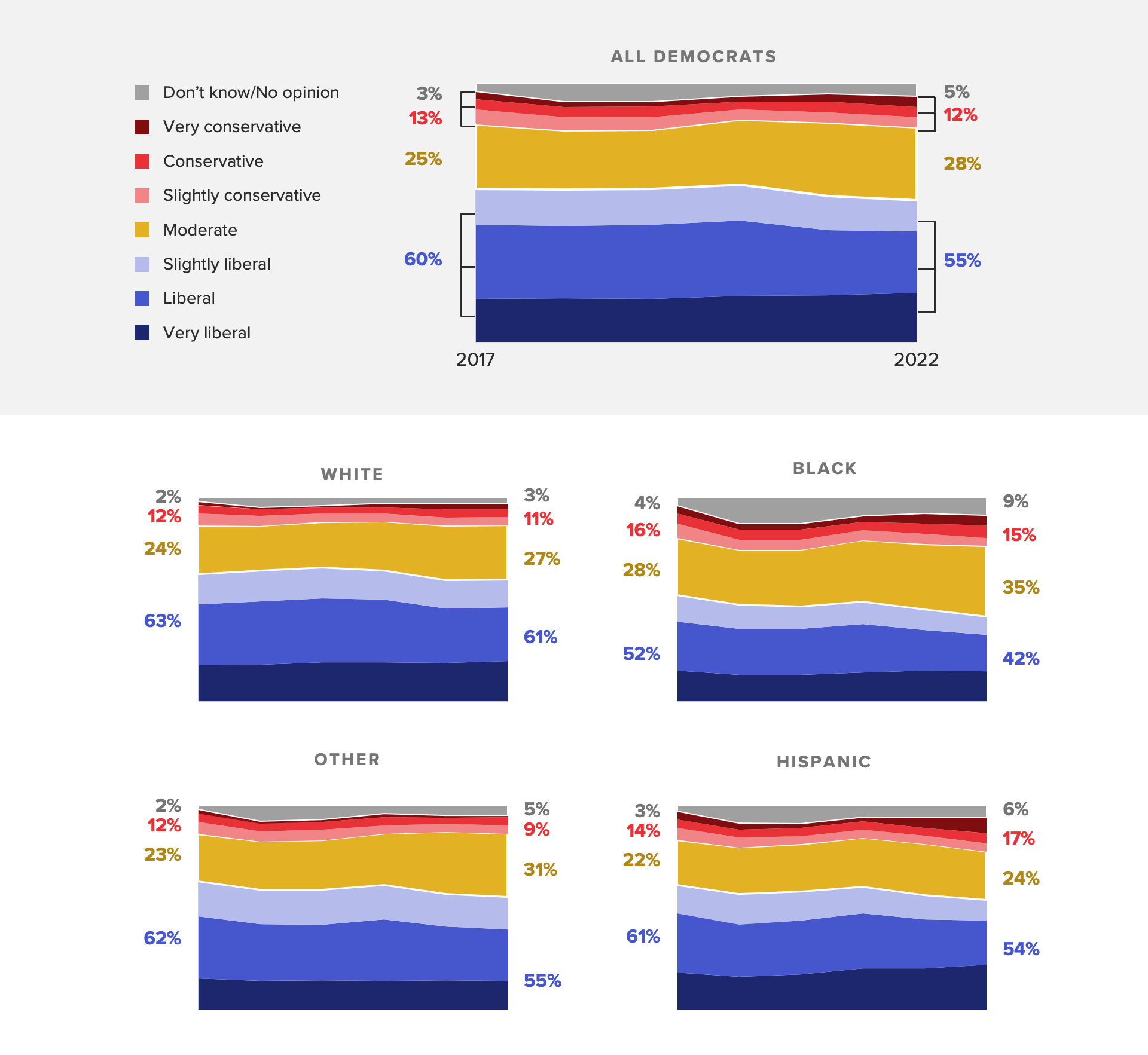America Has Become Less Liberal, but Not Necessarily More Conservative

Key Takeaways
The share of the electorate identifying as “very liberal,” “liberal” or “somewhat liberal” on a seven-point scale has dropped over the past five years, from 34% to 27%.
The decline in liberal self-identification has not led to a major increase in conservative alignment, the most prominent ideology in U.S. politics.
The data paints a crisp picture of asymmetrical polarization, as Democratic voters drifted toward the middle and Republican voters shifted further to the right.
The left is losing the battle for the minds of the American electorate, Morning Consult research shows, with voters decreasingly identifying as liberal in recent years. But that doesn’t mean the country is lurching to the right.
Instead, an increase in the share of Americans who identify as moderate, or who are uncertain about where exactly they stand on the ideological spectrum, reveals a growing and electorally decisive center that is discontented with either side’s extremes.
How America’s ideology is changing
The share of the electorate who identifies as “very liberal,” “liberal” or “somewhat liberal” on a seven-point scale has dropped over the past five years, from 34% to 27%, according to extensive annual Morning Consult survey research conducted among more than 8.6 million U.S. voters since 2017.
How the U.S. Electorate’s Ideology Has Changed Since 2017
Compared with 2017, the first year of Donald Trump’s presidency, the decline in liberal self-identification has not led to a major increase in conservative alignment, the most prominent ideology in U.S. politics, among the overall electorate. Rather, the proportion of voters who said they were moderate or uncertain about their ideology made up the difference.
The data shows Americans’ ideological identification is at least somewhat responsive to circumstances: Alignment with the right saw a decline during Trump’s tenure amid a surge of ideological uncertainty, while the inverse has played out since Joe Biden took the White House in 2021. Democratic data scientist David Shor, who has urged his party to embrace popular policies to not write off voters who might not be in perfect ideological alignment, said the findings are potentially “super important.”
“The historical march has been that ‘liberal’ is gradually increasing as the secular, college-educated population has increased in a way that's been divorced from thermostatic forces,” he said, referring to the political science theory about voters turning against the party in power. “If it’s thermostatic backlash, thermostatic backlash affecting ideological identification is new.”
The recent shifts appear to be driven by some of the racial and educational fault lines that have taken prominence in recent years, fueling a debate among Democratic activists, strategists and pundits about the direction of their party.

Responses were collected on an annual basis among at least 565,978 white voters each.
Voters without a college degree, who make up a large but shrinking share of the Democratic Party’s coalition, have moved further away from the “liberal” identifier than those with a bachelor's degree or a postgraduate education, with lesser-educated voters of color moving faster away from the left than their white counterparts.
While the nonwhite shift is pronounced by education, Black and Hispanic voters with a college education have also become less likely to identify as liberal in recent years.
Beyond educational differences, age also appears to play a role in the recession of liberalism. The share of young people — ages 18-34 — who identify as liberal has dropped more than the other age groups, followed by smaller declines among voters ages 35-44, 45-64 and those 65 or older, in that order. Among each age group, Black and Hispanic voters were more likely to move away from the ideological left than white voters.

Responses were collected on an annual basis among at least 181,524 voters each from ages 18-34.
It underscores a previously understood budding challenge with nonwhite voters for the Democratic Party, whose standard-bearers are increasingly viewed as liberal — as is the party.
According to the latest edition of Morning Consult’s annual State of the Parties survey, 73% of voters view the Democratic Party as liberal, up from 67% in mid-2017, with larger increases among voters without college degrees (62% to 70%) and Hispanics (65% to 75%). As voters moved away from the liberal identifier, they have also become more likely to associate the conservative label with the Republican brand (60% to 70%), including similar movement among the key demographic groups.
Overall, 42% of voters in a recent survey said the Republican Party is “too conservative,” up from 36% in 2017, compared with 45% who say the Democratic Party is “too liberal,” up from 40% in 2017.
In recent electoral contests, Republicans have increasingly looked to weaponize perceptions that Democrats are too far to the left.
“In 2020, with all the talk of a Hispanic shift, and an African American shift to a lesser degree, it was really kind of a shift among Hispanic conservatives. It was like, people already have this fixed ideological predisposition, and they’re just aligning that to their vote choice,” said Republican pollster Patrick Ruffini. “But what’s also happening, and reinforcing that, is the underlying ideological tendencies are also shifting in conjunction with, or caused by, vote choice.”
How partisan ideologies have changed
When it comes to the two major parties, the data paints a crisp picture of asymmetrical polarization. Even as Democratic voters drift toward the middle, the data shows that the Republican Party’s adherents are shifting further to the right — and it’s happening quickly.
Over the same time period in which the share of Democrats identifying as liberal dropped from 60% to 55%, the share of Republicans who said they were conservative increased from 70% to 77%. What’s more, Republican voters (32%) are far more likely to identify as “very conservative” than Democrats (19%) are to say they’re “very liberal.”

Responses were collected on an annual basis among at least 260,962 Democratic voters each.
On the Democratic side, white voters are more likely to identify as liberal than nonwhite voters, among whom the identifier has slumped since 2017. On the Republican side, the opposite took place over the same time period: While whites became slightly more conservative, the share of Black Republicans identifying with the right increased from 37% to 58%, alongside a similarly sized increase among Hispanic Republicans, from 48% to 66%.
Nonwhite voters are making up larger shares of both parties’ coalitions as their population expands, but the biggest coalitional movement has appeared among people with no coalition at all: Independent voters, a group whose ranks have become notably more racially diverse, well-educated and concentrated in the suburbs, and whose votes are often pivotal in close elections.
The bulk of independent voters (43%) identify as moderate, up from 34% in 2017, while the share who said they are liberal and conservative fell over the same time period.
Some Democratic pollsters noted that ideology is not equivalent to vote choice, and indeed, Morning Consult/Politico surveys have shown Democrats with a congressional generic ballot advantage over Republicans with all moderate voters (though independents are more evenly divided). Some have also shaken off the ideological labels entirely, alluding to the intraparty semantic debate over whether Democrats are “liberal” or “progressive.”
Shor said many operatives whose job it is to win elections think of things in terms of partisanship and base motivation, but noted that the two have become more correlated — not to mention the cleavages that ideological labels capture within the Democratic coalition on issues such as race and class.
Ruffini, who is writing a book on the role of ideology in American politics, referred to the growing share of voters aligning with the ideological middle — “largely non-college and disproportionately minority” — as “stranded” by the current political system. But even as their eschewing of liberalism is not precipitating a conservative surge, he sees opportunity for Republicans to weaponize this group to join the right in elections — due largely to the loudest voices on the left.
“The Republican Party is a conservative party. The Democrats are not necessarily a liberal party. The problem is its elite actors are polarized,” he said. “That’s what the last few years have been about, with Republicans hoping to capitalize on wokeness, the police and left-wing activist trends that get more play on the left than are actually warranted based on who their voters are.”
Eli Yokley is Morning Consult’s U.S. politics analyst. Eli joined Morning Consult in 2016 from Roll Call, where he reported on House and Senate campaigns after five years of covering state-level politics in the Show Me State while studying at the University of Missouri in Columbia, including contributions to The New York Times, Politico and The Daily Beast. Follow him on Twitter @eyokley. Interested in connecting with Eli to discuss his analysis or for a media engagement or speaking opportunity? Email [email protected].